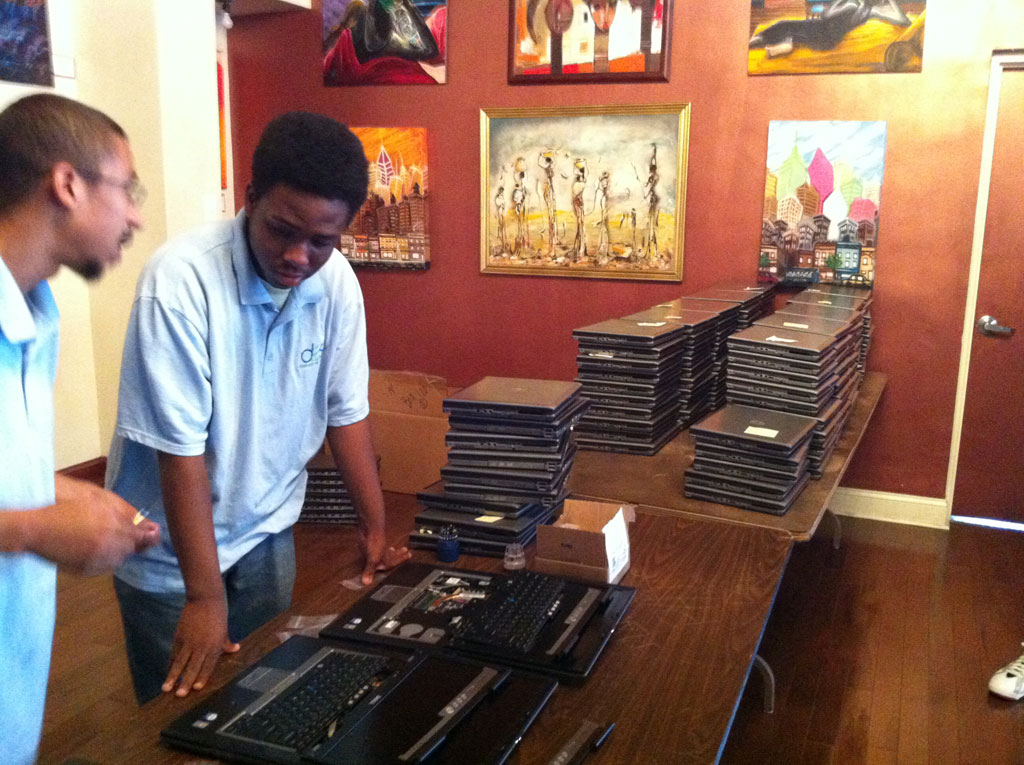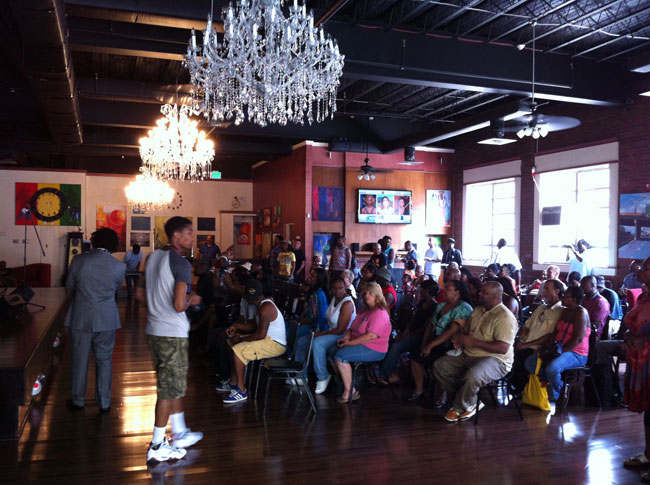An AP-15 rifle was the second gun collected by a SWAT officer of the Baltimore Police Department during Saturday’s Computers for Guns event in West Baltimore.
By 3:45 p.m., nearly an hour into the three-hour-long buy-back, 26 guns had been collected, including several .38-caliber handguns, a .22-caliber rifle and a shotgun, which was brought in by 62-year-old West Baltimore resident Marian Masso.
“It’s my father’s old shotgun,” she said. “I don’t want my nephews and grandkids to get a hold of it.”
Masso, along with others who had lined up outside the Downtown Cultural Arts Center in 90-degree heat, funneled into the lobby of the building one by one, handed over firearms wrapped in newspaper or bags or concealed in purses and received in exchange one playing card, redeemable for one refurbished Dell laptop outfitted with a new network card. By 6 p.m., at the end of the buy-back, more than 50 guns had been collected by the Baltimore Police Department — all of which are meant to be destroyed.
As for Computers for Guns organizer Lance Lucas, founder of the computer-training nonprofit Digit All Systems, the purpose of the event was to drive home a single message: trade a gun for a computer, stop shooting and start coding.
Over the last several weeks, news of shootings that have left more than 20 people dead has refocused the eyes of the mayor’s office and police commissioner Anthony Batts on violence in the city, both of whom appeared at a Friday morning press conference held at Digit All’s offices to promote Saturday’s technological spin on the traditional gun buy-back.
People “need hope and a pathway out” of violence, said Mayor Stephanie Rawlings-Blake.
But for all the talk about gun crime in Baltimore, Lucas said he felt compelled to make a tangible difference. He partnered with city police as well as the Mayor’s Office on Criminal Justice to organize Computers for Guns.
“We’re trading one thing for another,” said Lucas, 38, at Friday morning’s press conference as Rawlings-Blake, Batts and eight teenage boys who have received IT certifications through Digit All’s computer courses looked on. “Violence for education. Hatred for creativity.”
On Saturday, Lucas made sure that trade was celebrated: inside the arts center, people trading in guns mingled with other event attendees as a live band performed jazz and hip-hop music, chicken wings and mac and cheese were served and Kendrick Tilghman (better known as the STEM-teaching DJ 5 Starr) spun tracks on his turntables in the back of the room.
Notable, however, was the demographic of people who lined up at the intersection of North Howard and West Mulberry streets to trade in firearms.
The intended audience for Friday morning’s press conference was clearly black men of high-school age as well as those in their early twenties. An impassioned Elijah Cummings, U.S. representative for Maryland’s 7th district that includes nearly half of Baltimore city, implored young men to “put the guns aside and pick up a computer and empower yourselves.”
But many of those turning in firearms Saturday were middle-age or in their 50s or 60s, not, for instance, the age of recent MERVO High School graduate Alexis Radford, who was at Friday’s presser. Radford, who is taking four different certification courses at Digit All Systems this summer, will attend the University of Baltimore starting this fall and said he hopes to become an “ethical hacker” for the U.S. government.
Some, like 54-year-old West Baltimore Bradford Bell, a former Sylvan Learning Systems employee who hadn’t shot his .22-caliber rifle in 20 years, saw the event as a good opportunity to trade in something he no longer uses for a computer he definitely will use.
The stories shared by some trading in guns fit into general criticisms of gun-buy backs — namely, that those who turn them in are the least likely to be involved in criminal activity.
Still, Lucas said, it’s the idea of taking guns off Baltimore’s streets that’s significant. The remaining piece is systemic change to create pathways out of poverty for what he has called Baltimore’s “untapped population”: predominantly black Baltimoreans from overlooked neighborhoods with high unemployment rates.
“It’s not just a gun,” he said Saturday, ushering people through the lobby of the Downtown Cultural Arts Center and wiping sweat from his brow.
For Lucas, who was briefly living on the street before being accepted to Coppin State University, it’s about seizing power with a different type of metal machinery.
“We believe education is the only answer to poverty,” he said.
Before you go...
Please consider supporting Technical.ly to keep our independent journalism strong. Unlike most business-focused media outlets, we don’t have a paywall. Instead, we count on your personal and organizational support.
3 ways to support our work:- Contribute to the Journalism Fund. Charitable giving ensures our information remains free and accessible for residents to discover workforce programs and entrepreneurship pathways. This includes philanthropic grants and individual tax-deductible donations from readers like you.
- Use our Preferred Partners. Our directory of vetted providers offers high-quality recommendations for services our readers need, and each referral supports our journalism.
- Use our services. If you need entrepreneurs and tech leaders to buy your services, are seeking technologists to hire or want more professionals to know about your ecosystem, Technical.ly has the biggest and most engaged audience in the mid-Atlantic. We help companies tell their stories and answer big questions to meet and serve our community.
Join our growing Slack community
Join 5,000 tech professionals and entrepreneurs in our community Slack today!

The person charged in the UnitedHealthcare CEO shooting had a ton of tech connections

From rejection to innovation: How I built a tool to beat AI hiring algorithms at their own game

Where are the country’s most vibrant tech and startup communities?







